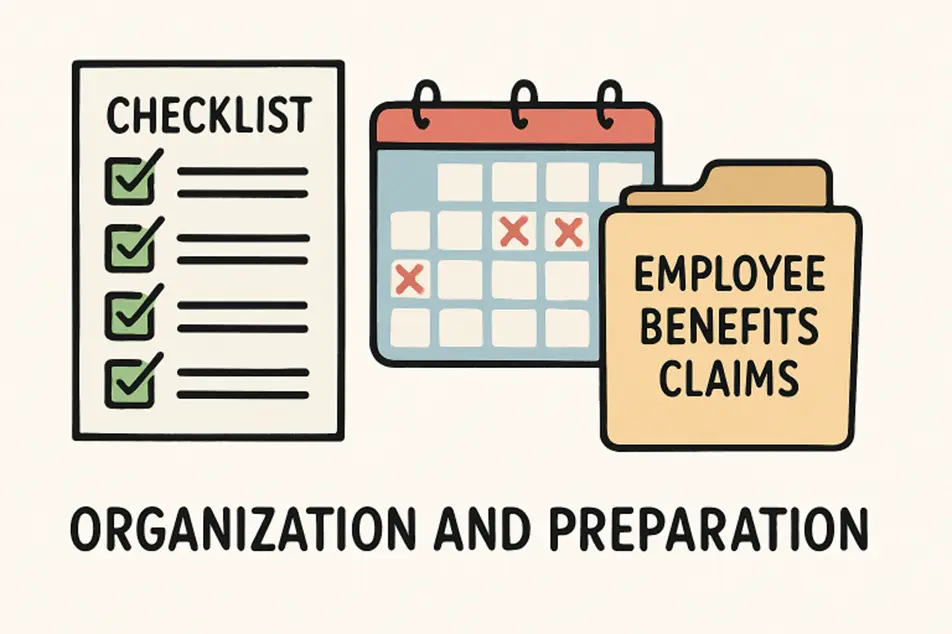Employee benefits claims are governed by stringent rules under the Employee Retirement Income Security Act (ERISA) and other laws. Many claim denials are caused by basic mistakes that could be prevented with careful attention to deadlines, documentation, and communication. Knowing the common pitfalls and how to address them gives you the best chance of success and financial stability as you manage your benefits.
Whether you’re filing a health insurance, retirement, life, or disability claim, proactive steps—like gathering relevant documents, verifying requirements, and asking clear questions—can make a vital difference.
Filing employee benefits claims can be complex and confusing, especially when a health issue, disability, or financial concerns already stress you. Small oversights can lead to delays, denials, and the potential loss of needed benefits. If you want to avoid costly errors, thoroughly understanding the claims process and your rights is essential. When in doubt, resources like benefitslaw.com offer direct access to legal expertise and guidance for workers throughout California. This article details the most frequent errors seen with employee benefit claims and provides practical solutions to avoid them in your own case.
Understanding mistakes before starting your claim will help secure the benefits you or your loved ones are entitled to. Accessing reliable legal and regulatory resources early can help you stay updated about employee benefits trends and best practices—essential reading for employees and HR professionals.
What Are Employee Benefits Claims?
Employee benefits claims are formal requests for payment or coverage made by workers or their beneficiaries under employer-sponsored plans. These benefits commonly include health insurance, retirement savings, disability insurance, and life insurance. For example, you may need to file a claim to access health benefits after surgery, collect disability payments following an accident, or secure retirement funds when leaving a job.
Most workplaces are governed by ERISA, the federal law that sets minimum standards for benefits plans and establishes key protections for claimants. The process typically starts with notification to your plan administrator and includes submitting specific forms and supporting documentation within the required deadlines. Understanding the basics of your plan’s procedures can help you avoid unnecessary complications.
Frequent Errors When Filing Benefits Claims
Benefit claims can be hindered by several common mistakes, including incomplete application forms, late submission, lack of necessary documentation, failing to appeal a denial, and poor communication with plan administrators. These errors can lead to immediate denials or requests for more documentation, resulting in lost rights. Employees should pay close attention to plan details and ensure clear communication to prevent these issues. They can better navigate the benefits process and avoid potential rejections by addressing these issues.
How to Read Plan Documents Effectively
The Summary Plan Description (SPD) is a crucial document in an employee benefit plan, outlining rights, coverage, procedures, and applicable limits. Employers typically provide it upon eligibility and should be reviewed annually or during qualifying events. Key claim language should be identified, including valid claim definitions, submission procedures, documentation requirements, and initial claims and appeals timelines. Early discovery can prevent misunderstandings and mistakes; if unclear, contact the HR department or plan administrator for clarification.
Meeting Essential Deadlines
Employee benefits claims are crucial, with specific deadlines set by each plan. Initial claims typically occur within 30-60 days, while appeals have shorter windows. To stay on track, use digital calendars or smartphone reminders to mark upcoming deadlines, and keep a checklist of required forms and documents. If you miss a deadline, contact your plan administrator and discuss options for good cause extensions or late submissions. Neglecting key dates is a common and preventable reason for losing benefits eligibility.
Documenting Claims Securely
Documentation is crucial for preventing disputes or errors. Securely store all correspondence, forms, receipts, and supporting evidence. Best practices include scanning or photographing important documents, backing them up to secure cloud storage, clearly labeling files, and keeping records updated with new communication. Document verbal communications with a written summary or confirmation email to the plan administrator. Effective documentation protects against appeals or mistakes later in the process.
Communicating Clearly with Plan Administrators
To resolve issues with your benefits claim, contact your plan administrator promptly and document every communication. Be specific about your questions and requests, including claim type, date, and issue. If you receive a denial, request a detailed reason in writing, including rationale and appeal procedures. Respond fully and within the specified time frame to request more information. Maintaining clear, professional, and traceable communication helps resolve issues before they escalate.
Where to Seek Additional Help
If you’re struggling to make sense of your plan’s requirements or believe your claim has been unfairly denied, don’t hesitate to seek professional advice. Employment lawyers and ERISA specialists can review your plan documents, help you gather evidence, and write appeals that comply with legal expectations.
Reputable organizations like the U.S. Department of Labor’s Employee Benefits Security Administration (EBSA) and your state’s Department of Insurance offer free resources and direct assistance for benefits inquiries. Connecting with knowledgeable support can differentiate between a contested and a successfully resolved claim.
Conclusion
Employee benefits claim denials often result from oversights or communication breakdowns. To protect yourself, read plan documents, meet deadlines, and maintain thorough records. Proactive communication and swift action can resolve disputes quickly. Utilize external resources like HR departments, attorneys, and government agencies to protect your rights and secure your benefits.
Also Read-Top Data Science Tools Powering Modern Fintech Solutions










